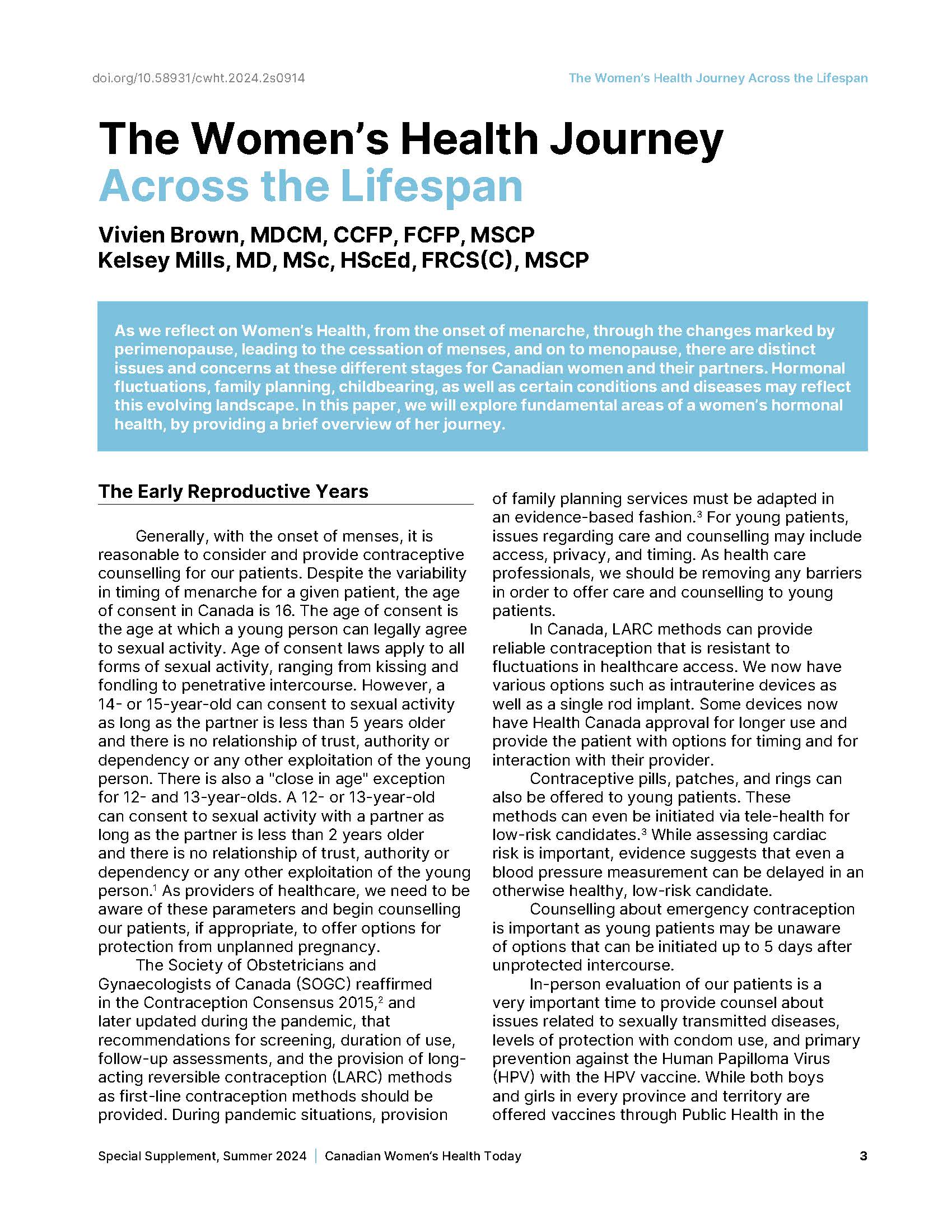The Women’s Health Journey Across the Lifespan
DOI:
https://doi.org/10.58931/cwht.2024.2s0914Abstract
Generally, with the onset of menses, it is reasonable to consider and provide contraceptive counselling for our patients. Despite the variability in timing of menarche for a given patient, the age of consent in Canada is 16. The age of consent is the age at which a young person can legally agree to sexual activity. Age of consent laws apply to all forms of sexual activity, ranging from kissing and fondling to penetrative intercourse. However, a 14- or 15-year-old can consent to sexual activity as long as the partner is less than 5 years older and there is no relationship of trust, authority or dependency or any other exploitation of the young person. There is also a "close in age" exception for 12- and 13-year-olds. A 12- or 13-year-old can consent to sexual activity with a partner as long as the partner is less than 2 years older and there is no relationship of trust, authority or dependency or any other exploitation of the young person. As providers of healthcare, we need to be aware of these parameters and begin counselling our patients, if appropriate, to offer options for protection from unplanned pregnancy.
The Society of Obstetricians and Gynaecologists of Canada (SOGC) reaffirmed in the Contraception Consensus 2015, and later updated during the pandemic, that recommendations for screening, duration of use, follow-up assessments, and the provision of long-acting reversible contraception (LARC) methods as first-line contraception methods should be provided. During pandemic situations, provision of family planning services must be adapted in an evidence-based fashion. For young patients, issues regarding care and counselling may include access, privacy, and timing. As health care professionals, we should be removing any barriers in order to offer care and counselling to young patients.
References
Miller BB, Cox DN, Saewyc EM. Age of sexual consent law in Canada: population-based evidence for law and policy. Can J Hum Sex. 2010;19(3):105–117.
Black A, Guilbert E, Costescu D, Dunn S, Fisher W, Kives S, et al. Canadian contraception consensus (Part 1 of 4). J Obstet Gynaecol Can. 2015;37(10):936–938. DOI: https://doi.org/10.1016/S1701-2163(16)30033-0
Black A, Costescu D, Guilbert E, Dunn S, Norman WV, Trouton K, et al. Contraception consensus: updated guidance during pandemics and periods of social disruption [Internet]. Ottawa, Canada: Society of Obstetricians and Gynecologists of Canada; 2020 Nov. [Cited 2024 July 15]: 1–9. Available from: https://sogc.org/common/Uploaded%20files/2020-04%20Contraception%20Consensus%20-%20Final%20Submitted.pdf
Public Health Ontario. Public Health Ontario Immunization coverage for school-based programs in Ontario 2019-2020, 2020-2021, 2021-2022 school years with impact of catchup programs [Internet]. [Cited 2024 July 15]. Available from: www.publichealthontario.ca
Delbaere I, Verbiest S, Tydén T. Knowledge about the impact of age on fertility: a brief review. Ups J Med Sci. 2020;125(2):167–174. DOI: https://doi.org/10.1080/03009734.2019.1707913
Leridon H. Can assisted reproduction technology compensate for the natural decline in fertility with age? A model assessment. Hum Reprod. 2004;19(7):1548–1553. DOI: https://doi.org/10.1093/humrep/deh304
Inhorn MC, Birenbaum-Carmeli D, Westphal LM, Doyle J, Gleicher N, Meirow D, et al. Patient-centered elective egg freezing: a binational qualitative study of best practices for women’s quality of care. J Assist Reprod Genet. 2019 Jun;36(6):1081–1090. DOI: https://doi.org/10.1007/s10815-019-01481-2
Weström L, Joesoef R, Reynolds G, Hagdu A, Thompson SE. Pelvic inflammatory disease and fertility. A cohort study of 1,844 women with laparoscopically verified disease and 657 control women with normal laparoscopic results. Sex Transm Dis. 1992;19(4):185–192. DOI: https://doi.org/10.1097/00007435-199207000-00001
Wiesenfeld HC, Hillier SL, Meyn LA, Amortegui AJ, Sweet RL. Subclinical pelvic inflammatory disease and infertility. Obstet Gynecol. 2012;120(1):37–43. DOI: https://doi.org/10.1097/AOG.0b013e31825a6bc9
Haggerty CL, Gottlieb SL, Taylor BD, Low N, Xu F, Ness RB. Risk of Sequelae after Chlamydia trachomatis genital infection in women. J Infect Dis. 2010;201 Supple 2:S134–S155. DOI: https://doi.org/10.1086/652395
Ochsendorf FR. Sexually transmitted infections: impact on male fertility. Andrologia. 2008;40(2):72–75. DOI: https://doi.org/10.1111/j.1439-0272.2007.00825.x
Mullick S, Watson-Jones D, Bekinska M, Mabey D. Sexually transmitted infections in pregnancy: prevalence, impact on pregnancy outcomes, and approach to treatment in developing countries. Sex Transm Infect. 2005;81(4):294–302. DOI: https://doi.org/10.1136/sti.2002.004077
World Health Organization (WHO). Global incidence and prevalence of selected curable sexually transmitted infections - 2008. Geneva; 2008. [Cited 2024 July 15]: 1–28. Available from: 9789241503839_eng.pdf (who.int)
Thorington R, Sawatzky P, Lefebvre B, Diggle M, Hoang L, Patel S, et al. Antimicrobial susceptibilities of Neisseria gonorrhoeae in Canada, 2020. Can Commun Dis Rep. 2022;48(11-12):571–579. DOI: https://doi.org/10.14745/ccdr.v48i1112a10
Government of Canada. Infectious syphilis and congenital syphilis in Canada, 2021 [Internet]. Public Health Agency of Canada; 2022 14 Dec. [Cited 2024 July 15]. Available from: https://www.canada.ca/en/public-health/services/reports-publications/canada-communicable-disease-report-ccdr/monthly-issue/2022-48/issue-11-12-november-december-2022/infectious-congenital-syphilis-canada-2021.html
Lamvu G, Carrillo J, Ouyang C, Rapkin A. Chronic pelvic pain in women: a review. JAMA. 2021;325(23):2381–2391. DOI: https://doi.org/10.1001/jama.2021.2631
Till SR, Nakamura R, Schrepf A, As-Sanie S. Approach to diagnosis and management of chronic pelvic pain in women. Obstet Gynecol Clin North Am. 2022;49(2):219–239. DOI: https://doi.org/10.1016/j.ogc.2022.02.006
Allaire C, Bedaiwy MA, Yong PJ. Diagnosis and management of endometriosis. CMAJ. 2023;195(10):E363–E371. DOI: https://doi.org/10.1503/cmaj.220637
Pérez-López FR, Ornat L, Ceausu I, Depypere H, Erel CT, Lambrinoudaki I, et al. EMAS position statement: Management of uterine fibroids. Maturitas. 2014;79(1):106–116. DOI: https://doi.org/10.1016/j.maturitas.2014.06.002
Santoro N. Perimenopause: from research to practice. J Womens Health (Larchmt). 2016;25(4):332–339. DOI: https://doi.org/10.1089/jwh.2015.5556
The 2022 Hormone Therapy Position Statement of The North American Menopause Society Advisory Panel. The 2022 hormone therapy position statement of The North American Menopause Society. Menopause. 2022;29(7):767–794. DOI: https://doi.org/10.1097/GME.0000000000002028
Johnston S, Bouchard C, Fortier M, Wolfman W. Guideline No. 422b: Menopause and genitourinary health. J Obstet Gynaecol Can. 2021;43(11):1301–1307. DOI: https://doi.org/10.1016/j.jogc.2021.09.001

